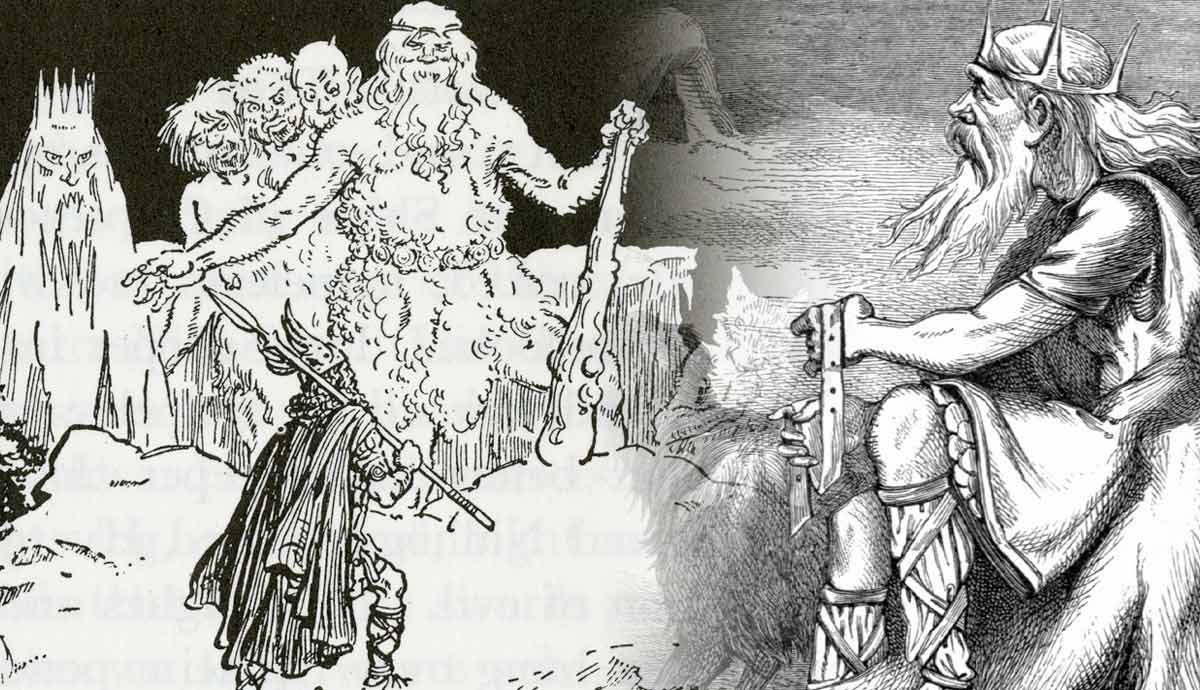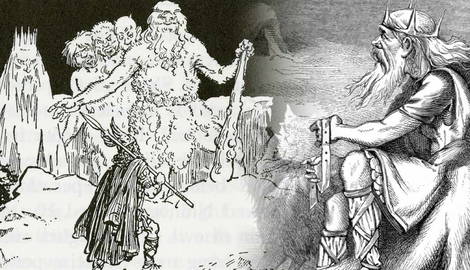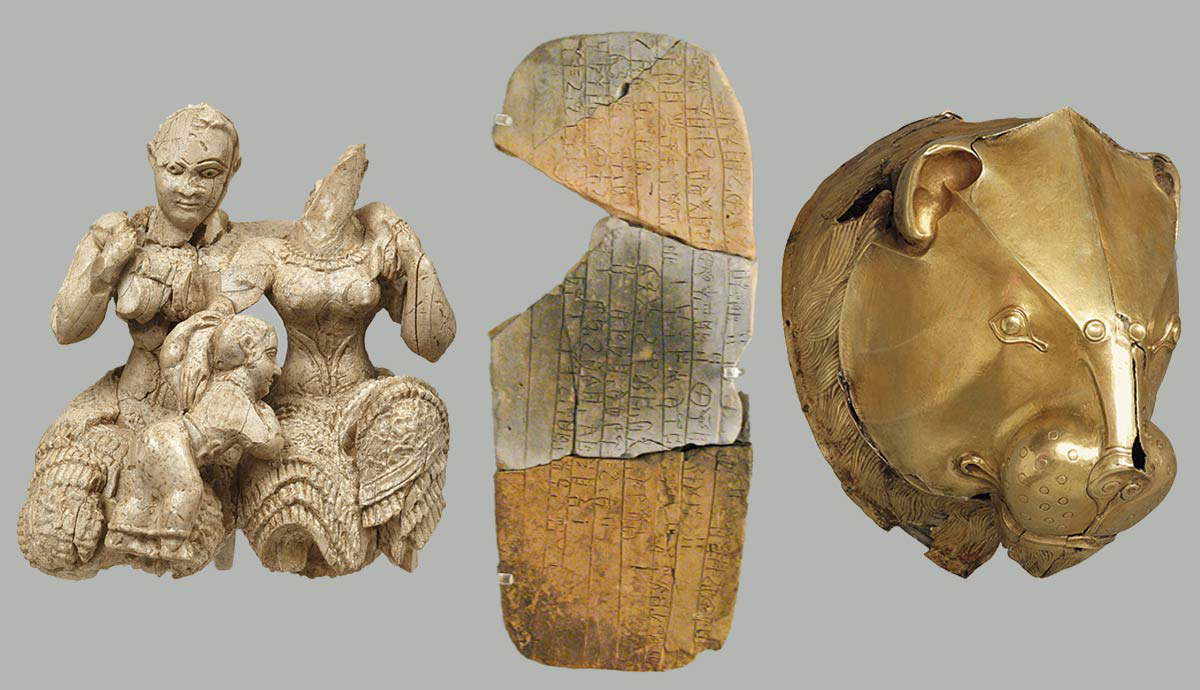
If you have read stories from Norse mythology, then you have probably heard of the battles between the gods and the giants and will be familiar with at least one giant, the trickster Loki. But if you go back and read the original stories, you will not encounter the word giant. Instead, you will meet the Jotun.
While the word giant is commonly used in modern retellings of these old stories, it is problematic since the jotun were rarely large in stature. Rather, they seem to be a group of supernatural beings very similar to the gods themselves. So similar, that there are many examples of gods and jotun mating. While the jotun are described as the ancient enemies of the gods, they seem very friendly in most of the surviving stories about them.
Creation of the Jotun

The jotun are some of the oldest beings in the Norse cosmos, even older than the gods themselves. According to the Norse creation myth, at the beginning of time, there was a giant void called the Ginnungagap in which nothing existed. But at the far reaches of the void, at the very top, was a source of heat and fire known as Muspell. At the very bottom of the void was a source of ice and mist.
Over a great period, the heat and mist seeped into the Ginnungagap and mixed to create a primordial goop. It was from this goop that life emerged. The first two creatures were a primordial cow called Audumbla and the very first jotun, Ymir.

The Jotun sustained himself by drinking Audumbla’s milk, while she sustained herself by licking at salt rocks that also emerged from the primordial goop. After three days of feeding, she licked the first of the gods, Buri, from this salt rock.
Both Ymir and Buri went on to procreate and they were the progenitors of all the jotun and the gods. Ymir is described as giving birth asexually, with many jotun jumping from his skin as he sweats. While most are “humanoid,” described as men and women, Ymir also gave birth to some monstrous-looking jotun, including a six-headed being that sprung forth from one of his legs.
Meanwhile, both Buri and Ymir’s jotun offspring seem to have given birth “the old-fashioned way.” While we do not know exactly how Buri had his son, Bor, we do know that his son mated with the jotun Bestla and had three sons, Odin, Vili, and Ve.
This part of the Norse creation myth provides a few pieces of important information. First, the jotun came into existence before the gods. Second, that the jotun and the gods aren’t that different since they were able to have children together. But they are not the same. In the Gylfaginning in the Prose Edda, Odin, in the guise of High, assures King Gylfi that Ymir is no god, but a monstrous jotun like all his offspring. Nevertheless, Odin and his brothers are never described or considered “half jotun,” they are always simply gods.
Destruction of Ymir

While the gods and lesser jotun were mating and procreating, more jotun continued to spring forth from Ymir. This meant that the jotun quickly outnumbered the gods. While the creation myth does not list any crimes or problems caused by the jotun, we are perhaps meant to infer from their very nature that they were causing chaos in the universe. Whatever their justification, Odin and his brothers decided to kill Ymir.
When they killed the primordial jotun, they decided to use his immense body to shape the world. This is one of the few references to the jotun as “giant” in stature, and Ymir does seem to be a special case.
They took Ymir’s body to the middle of the Ginnungagap and used it to fashion the earth and used his gushing blood to create the lakes and seas. His bones and teeth became rocks and stones. They took his skull and hung it over their new earth to create the sky.
This new earth seems to have encompassed two of the nine worlds of the Norse cosmos. The earth they created was a circular disk, and they gave the outskirts of the land to the jotun. It became their homeland, Jotunheim. They then used Ymir’s eyelashes to separate Jotunheim from the inner land, which they called Midgard. The gods also created mankind to populate it.

It was probably at this time that the gods separated some of the other worlds. They decided to build their home world of Asgard separate from their new creation but they also built the Rainbow Bifrost Bridge to give them access to Midgard.
At this time, they also seem to have closed off the Muspell, creating a world called Muspelheim. Some jotun, led by a fire jotun called Surtr, were also trapped in this world when it was closed off. They are called fire jotun to distinguish them from the other jotun, who are sometimes called frost jotun in popular culture, although this term is not common in the surviving myths.
The gods may have done something similar with the world of cold and mist and created Niflheim. While the gods could travel to Niflheim, as we know that Odin often visited Mimir there at the Well of Wisdom, the underworld of Helheim was also placed there. Crossing into the realm of the dead was challenging and treacherous. How the other worlds of the Norse cosmos were created is unclear. What is clear is that the Vikings believed they lived in a world fashioned from the corpse of a jotun.
The Realm of Jotunheim

According to descriptions in the surviving sources, Jotunheim is a grim and harsh realm with dark forests and barren mountains. There is no fertile land to cultivate, so the jotun rely on hunting and fishing.
Jotunheim is also sometimes called Utgard, which means “world beyond the fence.” While this must refer to the fence that Odin created, it is also a general term for communities that exist beyond the boundaries of established civilization. This is another way in which Jotunheim is different from Midgard and Asgard, which are “gards” specifically within the law and protection of the gods.
This aligns with how Jotunheim is described in the story of Thor visiting the hall of Utgard-Loki recorded by Snorri Sturluson. From his arrival, until he leaves, everything seems impossible. There are jotun with skulls that cannot be crushed, cats that are too heavy to be lifted, and bottomless drinking flasks. In the end, everything turns out to be an illusion. But it seems that this story was meant to be a fairytale, rather than a faithful description of the realm.

Other stories describe Jotunheim as much more like the realm of men, with strong leaders ruling from great halls. Asgard is also described in the same way, with each of the gods having a great hall. This suggests that all worlds were considered a reflection of the human world.
For example, when the jotun Thrym steals Thor’s hammer, he will only return it in exchange for the hand of Freyja in marriage. While she refuses, Thor dresses up as Freyja and goes undercover as the bride to get his hammer back. He attends a great feast, where there is to be a traditional wedding ceremony, which is disrupted when Thor snatches his hammer and kills all the jotun.
The jotun also seem similar to the gods in terms of their stature, strength, and what they are capable of. They are usually described as “humanoid,” like men and the gods, but not always. We know that Ymir gave birth to at least one six-headed beast, and this was not the only monstrous jotun. The jotun witch Angrboda is described as living in the Ironwood and running with wolf packs. She can become a wolf herself and many of her children are wolves. Moreover, she had three children with the jotun Loki. She had a great wolf called Fenrir, a giant serpent called Jormungandr, and a half-living and half-dead daughter called Hel. While not typical, these offspring were also jotun.
Enemies of the Gods

The jotun are generally described as the ancient enemies of the gods. Thor, as the strongest of the gods, is charged with protecting both Asgard and Midgard from the jotun, which he does with his hammer Mjolnir. But in most surviving stories, the jotun and the gods seem cozy.
Take the jotun Loki. He is allowed to live in Asgard among the gods because of a pact between himself and Odin. He is treated as one of the gods, attending their meetings and giving advice. For example, he helps the gods trick a builder into building the fortifications of Asgard for no pay. In the end they discover that the builder is a jotun and kill him for that reason alone. Nevertheless, Loki could take a goddess for a wife, Sigyn.
Loki makes some trouble, but it is usually just pranks, such as when he removed the hair of Thor’s wife Sif. This resulted in Loki having to procure something to replace it, which also saw him procure other treasures such as Thor’s hammer. Loki sometimes gets in more serious trouble, such as when he helped the jotun Thjazi kidnap the goddess Idun. But again, he also helped the gods solve the problem later.
Loki only fell out with the gods when he plotted and caused the death of Balder, the son of Odin and Sif. After this, the gods no longer accepted him, leading to the famous Lokasenna dinner story in which Loki insults most of the gods and reveals some cryptic secrets about each. In the end, they decided to imprison him. They shackled him to a stone and hung a venomous snake over him to drip poison onto his body.

But Loki is not the only jotun who gets pretty cozy with the gods. Many gods mate with Jotun women. Odin had Thor with the jotun Jord, Thor had his two sons with the jotun Jarnsaxa, and Freyr married the jotun Gerd, to name just a few.
Other jotun were also welcome in Asgard. The jotun Skadi showed up in Asgard seeking justice after the gods killed her father Thjazi. They offered to pay her for the death, and this payment included letting her marry one of the gods. The catch was that she had to choose her husband by looking only at their feet.
While Skadi wanted to marry the beautiful god Balder, she instead chose the sea god Njord. The marriage didn’t last long as the two were just too different, but Skadi continued to be accepted in Asgard. She even became one of Odin’s lovers. Plus, in the story of the punishment of Loki, it is Skadi who procures the serpent and hangs it over Loki’s head.
In return, the gods also seem to have been welcome on most of their trips to Jotunheim. In another story, Thor goes to visit the jotun Hymir, who is described as the father of the god Tyr. He is there to borrow a cauldron to brew enough mead for a big party that the gods are planning in the hall of Aegir, another jotun.
While Thor annoys his host by eating everything in sight and trying to catch the great serpent Jormungandr on his fishing line, he is treated as a welcome guest. This atmosphere of mutual acceptance characterizes most stories of interactions between the gods and jotun.
The Jotun at Ragnarök

Despite these cordial relations, Ragnarök, the Norse apocalypse, is described as a battle until mutual destruction between the gods and the jotun. So, what happens? The specific cause we are given in the sources is the falling out between the gods and Loki. Even before the death of Balder, things may have been strained. When the gods learned about the children of Loki and Angrboda, they deemed them too dangerous to run free and decided to deal with them, much as they had previously with Ymir.
Rather than kill the children, they placed each somewhere they could do the least harm. They chained up Fenrir, threw Jormungandr into the waters surrounding Midgard, and sent Hel to be the mistress of the underworld. While it is not stated in the surviving sources, Loki’s determination to kill Balder may have been motivated by the treatment of his own children.
The death of Balder is then the final straw, with the gods fully turning on Loki. This drives a wedge between the gods and at least one jotun family. When Ragnarök comes, it is then no surprise that it is Loki and his children who are leading the charge.
The other main Jotun player in Ragnarök is the fire jotun, Surtr, who seems to have been imprisoned with others of his kind in Muspelheim since the creation of Midgard. Ragnarök also allows him to break out of his prison and seek revenge.
In the end, Odin is killed by Fenrir, who is in turn killed by Odin’s son Vidarr. Thor kills Jormungandr but dies shortly after from the snake’s venom. Loki and Heimdall kill one another. Freyr and Surtr kill one another. The battle causes so much destruction that the realms created by Odin and his brothers following their murder of Ymir are destroyed.










